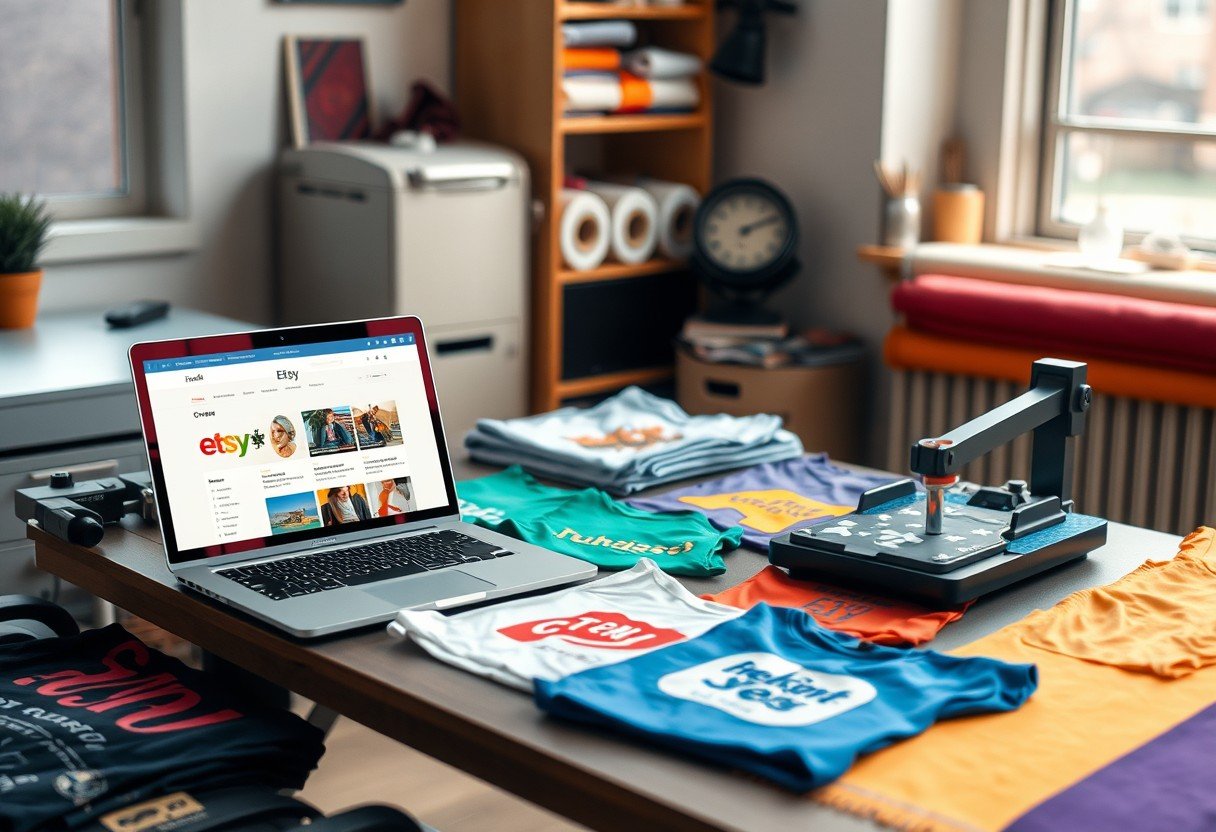Starting an Etsy T-shirt shop is a fantastic way to turn your creative ideas into a profitable business. This guide breaks down exactly how to launch your store, from finding a unique niche to mastering marketing. By understanding the key steps, you can tap into Etsy’s large community of shoppers who are actively looking for custom and one-of-a-kind products, setting yourself up for long-term success.
Getting Started: Setting up Your Etsy Shop Foundation
Your first step is creating an Etsy account, which is the gateway to your new business. This process is simple and involves providing an email and choosing a shop name. Think carefully about your shop name, as it’s the first piece of your brand that customers will see. It should be memorable and reflect the style of T-shirts you plan to sell.
Once your account is active, you’ll need to set up your shop profile. This involves filling out your shop’s bio, uploading a logo or banner, and defining your policies. Clear policies on shipping, returns, and exchanges are crucial. They build trust with buyers by managing their expectations from the start.
Setting up a strong foundation involves more than just filling in blanks. It’s about creating a brand identity. Here are the essential steps to complete:
- Complete Your Shop Profile: Add a compelling story about your brand and what makes your T-shirts special.
- Upload High-Quality Branding: Create a unique logo and shop banner that visually represent your niche.
- Define Shop Policies: Clearly state your rules for shipping times, returns, and exchanges to avoid confusion later.
- Set up Payment and Billing: Connect your bank account so you can get paid and Etsy can collect its fees.
Taking the time to complete these steps thoughtfully will make your shop look professional and reliable to potential customers. It is a critical part of building a successful Etsy T-shirt business.
Finding Your Place: How to Research Your Market and Niche
Before you design a single shirt, you need to understand the market. Thorough research helps you discover what’s trending, what customers are searching for, and where you can fit in. This isn’t about copying others, but about identifying opportunities.
Identifying your niche is one of the most important things you will do. Instead of trying to sell to everyone, focus on a specific theme, style, or audience. Are you passionate about vintage-style travel shirts, funny T-shirts for cat lovers, or motivational workout tops? A well-defined niche will help you connect with buyers who are looking for exactly what you offer.
Take a close look at other successful T-shirt shops in your chosen niche. Analyze their branding, what prices they set, and how they talk to their customers. Pay attention to their reviews to see what shoppers love and what they complain about. This analysis will reveal gaps in the market that your shop can fill, helping you stand out from the competition.
From Concept to Creation: Designing Your T-Shirts
Now for the fun part: designing your T-shirts. Your designs should reflect your unique style and appeal directly to your niche audience. While it’s smart to be aware of current trends, your originality is what will make your brand memorable. Whether you’re skilled in typography, graphic illustrations, or simple patterns, find a balance that feels authentic to you.
You don’t need to be a professional graphic designer to create amazing T-shirts. There are many user-friendly tools available that can help bring your vision to life.
- Canva: An excellent choice for beginners, offering thousands of templates and easy-to-use features for creating text-based and simple graphic designs.
- Adobe Illustrator: The industry standard for professional designers, offering powerful tools for creating complex vector graphics that scale perfectly.
- Procreate: A popular choice for artists who prefer to draw their designs by hand on an iPad.
The quality of your final product is just as important as the design itself. Investing in high-quality fabrics and reliable printing methods will lead to happy customers and positive reviews. Soft, durable shirts made from cotton or a cotton-blend are often the best choice. Research reputable print-on-demand suppliers or local printers to ensure your designs are printed beautifully and your shirts feel great to wear.
The Price is Right: A Guide to Pricing Your T-Shirts
Pricing your T-shirts correctly is a delicate balance. You need to cover all your costs, make a profit, and offer a price that customers feel is fair for the quality you provide. Setting a price that is too low can devalue your brand, while a price that is too high can scare away potential buyers.
The first step is to calculate every single cost associated with selling one T-shirt. This includes the price of the blank shirt, printing fees, Etsy’s listing and transaction fees, shipping supplies, and any marketing expenses. Once you have a total cost per shirt, you can add your desired profit margin to set a final retail price.
Here is a simplified example of how to calculate your costs:
| Cost Item | Example Price | Notes |
|---|---|---|
| Blank T-Shirt | $5.00 | The cost of the physical shirt. |
| Printing Fee | $8.00 | The cost from your print-on-demand partner. |
| Etsy Fees (approx.) | $2.50 | Includes listing, transaction, and payment processing. |
| Total Cost | $15.50 | This is your break-even price. |
After calculating your costs, research what similar T-shirts in your niche are selling for on Etsy. This will give you a good idea of the market rate. Your goal is to set a competitive price that reflects the uniqueness and quality of your designs without undercutting your business’s ability to be profitable.
Getting Seen: Effective Marketing for Your Etsy Shop
Creating great T-shirts is only half the battle; now you need to get them in front of the right people. A solid marketing strategy is essential for gaining visibility in Etsy’s crowded marketplace. Your focus should be on building a brand that resonates with your target audience and actively promoting your products.
Social media is one of the most powerful marketing tools available to you. Platforms like Instagram, Pinterest, and TikTok are highly visual and perfect for showcasing your T-shirt designs. Share high-quality photos and videos of your products, engage with your followers by asking questions, and use relevant hashtags to reach a wider audience interested in your niche.
Don’t overlook the marketing tools that Etsy provides directly. Using strong, relevant keywords in your product titles, descriptions, and tags is crucial for SEO (Search Engine Optimization). This helps customers find your products when they search on Etsy. You can also use Etsy Ads to promote your listings to targeted shoppers on the platform. Regularly check your shop’s stats to see which keywords are driving traffic and which marketing efforts are leading to sales.
Running a Smooth Operation: Order Management and Customer Service
Once the sales start coming in, efficient order management and excellent customer service become your top priorities. Staying organized and responsive is key to keeping customers happy and encouraging them to come back. Check your shop daily for new orders and aim to process them quickly, whether you’re shipping them yourself or using a print-on-demand service.
Communication is essential for building a great reputation. Respond to customer questions and concerns as quickly and politely as possible. A friendly and helpful response can turn a potential issue into a positive experience. After a customer receives their order, consider sending a follow-up message to thank them and gently encourage them to leave a review. Positive reviews are incredibly valuable for building trust with new buyers.
Engaging with customers helps build a community around your brand. You can foster loyalty by sharing user-generated content, like photos of customers wearing your T-shirts, on your social media pages. Making your customers feel valued transforms them from one-time buyers into loyal fans who will happily promote your shop to others.
Frequently Asked Questions about Starting an Etsy T-Shirt Shop
How much does it cost to start an Etsy T-shirt shop?
The initial costs can be very low, especially if you use a print-on-demand service. Your main expenses will be Etsy’s listing fees ($0.20 per listing), design software, and any marketing costs you choose to invest in. You avoid the cost of buying inventory upfront with print-on-demand.
What kind of T-shirt designs sell best on Etsy?
Designs that cater to specific niches tend to sell best. This includes T-shirts related to hobbies, professions, funny quotes, seasonal events, and personalized graphics. Researching current trends within your chosen niche is the best way to find popular ideas.
Do I need my own equipment to start an Etsy T-shirt business?
No, you do not need your own equipment. Many successful Etsy shops use print-on-demand (POD) services. These companies handle the printing, packaging, and shipping for you, so you only need to focus on creating designs and marketing your shop.
How do I make my Etsy shop stand out?
To stand out, focus on a specific niche, create high-quality and original designs, and take excellent product photos. Building a strong brand identity with a memorable name and logo, and providing outstanding customer service will also help differentiate your shop from competitors.
Should I offer custom T-shirt designs?
Offering custom designs can be a great way to attract customers looking for unique, personalized gifts. However, it requires more communication and design time per order. You can start with pre-made designs and consider adding a custom option once your shop is more established.









Leave a Comment